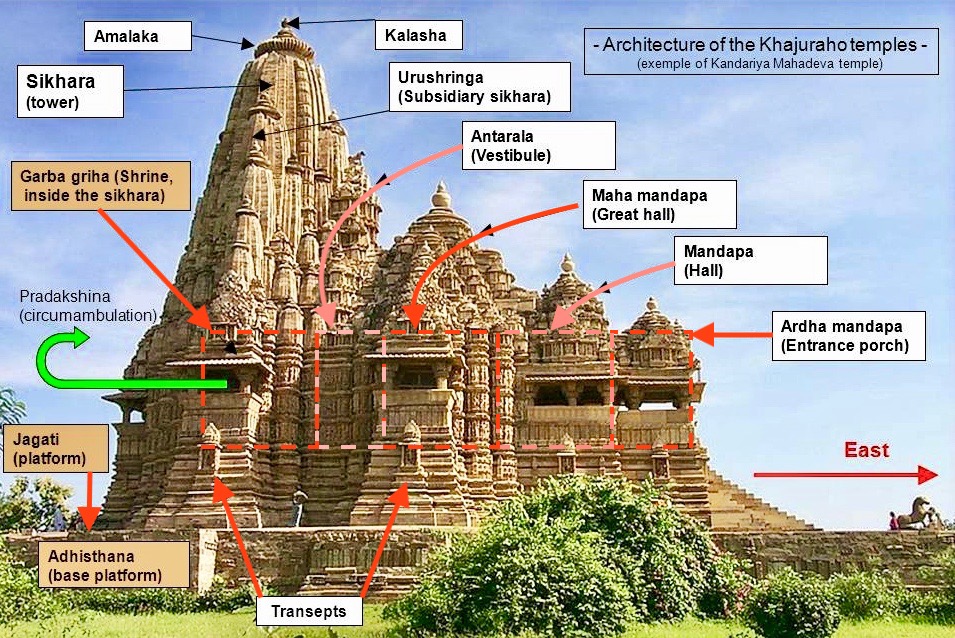
The architecture of Hindu temples evolved over a period of more than 2,000 years and there is a great variety in this architecture. Hindu temples are of different shapes and sizes – rectangular, octagonal, semicircular – with different types of domes and gates. Temples in southern India have a different style than those in northern India. Although the architecture of Hindu temples is varied, they mainly have many things in common.
The 6 parts of a Hindu Temple:
1. The Dome and Steeple: The steeple of the dome is called ‘shikhara’ (summit) that represents the mythological ‘Meru’ or the highest mountain peak. The shape of the dome varies from region to region and the steeple is often in the form of the trident of Shiva.
2. The Inner Chamber: The inner chamber of the temple called ‘garbhagriha’ or ‘womb-chamber’ is where the image or idol of the deity (‘murti’) is placed. In most temples, the visitors cannot enter the garbhagriha, and only the temple priests are allowed inside.
3. The Temple Hall: Most large temples have a hall meant for the audience to sit. This is also called the ‘nata-mandira’ (hall for temple-dancing) where, in days of yore, women dancers or ‘devadasis’ used to perform dance rituals. Devotees use the hall to sit, meditate, pray, chant or watch the priests perform the rituals. The hall is usually decorated with paintings of gods and goddesses.
4. The Front Porch: This area of the temples usually has a big metallic bell that hangs from the ceiling. Devotees entering and leaving the porch ring this bell to declare their arrival and departure.
5. The Reservoir: If the temple is not in the vicinity of a natural water body, a reservoir of fresh water is built on the temple premises. The water is used for rituals as well as to keep the temple floor clean or even for a ritual bath before entering the holy abode.
6. The Walkway: Most temples have a walkway around the walls of the inner chamber for circum-ambulation by devotees around the deity as a mark of respect to the temples god or goddess.
Temple Priests:
As opposed to the all-renouncing ‘swamis’, temple priests, variously known as ‘pandas’, ‘pujaris’ or ‘purohits’, are salaried workers, hired by the temple authorities to perform daily rituals. Traditionally they come from the Brahmin or priestly caste, but there are many priests who are non-Brahmins.
The 6 parts of a Hindu Temple:
1. The Dome and Steeple: The steeple of the dome is called ‘shikhara’ (summit) that represents the mythological ‘Meru’ or the highest mountain peak. The shape of the dome varies from region to region and the steeple is often in the form of the trident of Shiva.
2. The Inner Chamber: The inner chamber of the temple called ‘garbhagriha’ or ‘womb-chamber’ is where the image or idol of the deity (‘murti’) is placed. In most temples, the visitors cannot enter the garbhagriha, and only the temple priests are allowed inside.
3. The Temple Hall: Most large temples have a hall meant for the audience to sit. This is also called the ‘nata-mandira’ (hall for temple-dancing) where, in days of yore, women dancers or ‘devadasis’ used to perform dance rituals. Devotees use the hall to sit, meditate, pray, chant or watch the priests perform the rituals. The hall is usually decorated with paintings of gods and goddesses.
4. The Front Porch: This area of the temples usually has a big metallic bell that hangs from the ceiling. Devotees entering and leaving the porch ring this bell to declare their arrival and departure.
5. The Reservoir: If the temple is not in the vicinity of a natural water body, a reservoir of fresh water is built on the temple premises. The water is used for rituals as well as to keep the temple floor clean or even for a ritual bath before entering the holy abode.
6. The Walkway: Most temples have a walkway around the walls of the inner chamber for circum-ambulation by devotees around the deity as a mark of respect to the temples god or goddess.
Temple Priests:
As opposed to the all-renouncing ‘swamis’, temple priests, variously known as ‘pandas’, ‘pujaris’ or ‘purohits’, are salaried workers, hired by the temple authorities to perform daily rituals. Traditionally they come from the Brahmin or priestly caste, but there are many priests who are non-Brahmins.
Thus, those who are struggling with a low credit score history could also sign up for this finance scheme not fake the
ReplyDeleteratings are based solely around the unconditional
and irrevocable corporate guarantee extended by tnwml's parent
company, ramky enviro engineers limited reel, for your rated loans.
After I initially commented I appear to have clicked the -Notify me when new comments are added- checkbox and from now on each
ReplyDeletetime a comment is added I get 4 emails with the exact same
comment. Is there an easy method you can remove me from that service?
Appreciate it!
Feel free to surf to my web page ... Is Muscle Gaining Secrets A Scam
(blogspot.com)
Hi there it's me, I am also visiting this web page daily, this site is really nice and the viewers are genuinely sharing nice
ReplyDeletethoughts.
Here is my blog post Reviews on Get Rid of Herpes - blogspot.com -
Hmm is anyone else encountering problems with the pictures on this blog loading?
ReplyDeleteI'm trying to figure out if its a problem on my end or
if it's the blog. Any suggestions would be greatly appreciated.
Here is my web page - popular diets for weight loss
Very Informative blog.
ReplyDeleteSai Baba Answers
Excellent blog.
ReplyDeleteSai Satcharitra Kannada pdf
Sai Satcharitra Marathi pdf
Sai Satcharitra Malayalam pdf
Sai Satcharitra Gujarati pdf
Free Job Posting Sites | Library Genesis
ReplyDelete